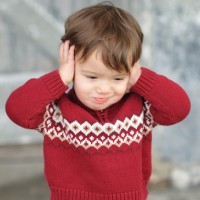Written by Andrea Gayle, MOT OTR/L, Mecklenburg County CDSA
We have all witnessed a toddler with difficult behaviors or several tantrums in a day. When toddlers are at or around the age of two they typically are classified as entering the “Terrible Twos.” But what if it is more than that? What if there is some underlying cause or reason for all the extreme emotional behavior changes, tantrums, or even meltdowns. As an Occupational Therapist, I start to wonder what role self-regulation plays in behavior and emotional control. As early interventionist, we are taught to look at a family’s routine and think in terms of function, but for some families dealing with challenging behaviors, they may feel that a ‘typical’ routine does not exist.
Toddlers who may have trouble with self-regulation typically have erratic sleep patterns, are often picky eaters, can be easily distracted or shift their attention among many things, and have extreme reactions to transitions or changes in their surroundings. Toddlers who may have trouble with self-regulation fall into two categories:
(1) hyper-reactive – toddlers that easily have reactions that are over the top; or
(2) hypo-reactive – toddlers that struggle to have typical reactions or to stay alert.
Optimally, we all should have a certain balance between responses that are hypersensitive (too sensitive), hyposensitive (not sensitive enough), and craving (sensory seeking). When this balance exists, it creates an ideal, or well-balanced, response to all the information a toddler may receive both internally (responses and interpretations by the brain) and externally (environmental changes that cannot be controlled).
As we study sensory processing and its impact on infants and toddlers, we learn that sensory processing affects the whole child. How a toddler processes sensory input can effect:
- Sensory Modulation – a child’s ability to demonstrate appropriate responses to stimuli they receive. For example, when a toddler is upset, they should be able to calm easily when provided with a hug or attention from their parents, versus continuing to cry and be inconsolable
- Sense Discrimination a child’s ability to discriminate stimuli received from each of the seven senses-touch, taste, smell, sight, hearing, vision, vestibular, and proprioceptive. For example, a toddler should be able to explore toys with his hands during play, versus constantly putting toys in their mouth in attempts to gain additional information or understanding.
- Motor Skills- gross (large) muscles and fine (small) muscles. For example, a toddler should be able to safely use his arms and legs to climb onto and off of furniture without falling or navigate steps/stairs safely with the supervision of a parent.
So as early interventionist, how can we support parents and caregivers to help toddlers find a balance and help them get past this “Terrible Two” stage?
- Give them a life rich with sensory input by building sensory opportunities into the day at home and daycare. This can be done through activities that provide heavy work exercises (i.e. pushing or pulling loaded wagons or laundry baskets of closes), deep pressure (i.e. firm massage or squeezes to arms and legs while dressing), and physical play (i.e. play wrestling or jumping games at the playground).
- Provide gradual exposure to stimulation that is scary or that may trigger difficult behaviors (i.e. calling ahead and taking a child to the library or discovery place during a slow time of day or for an unscheduled day for short intervals – to the door, for five minutes, 10 minutes, etc.).
- Model desired behaviors and then provide a token or reward system for success (i.e. show a child the expected behavior, and then present them with a picture chart with a special time with you or prize that they can work toward),
- Try to prevent sensory overload by suiting activities to the toddler and his/her environment, keeping the activities simple, and helping him/her maintain regulation over time and train the body to new habits (i.e. tailor it to the day – if it is a rough day, provide safe places the toddler can have melt-downs or where they can retreat in order to regroup). Use what you have (i.e. blankets and pillows in order to make a safe place, which can be used in play and for a time of retreat – Not For Punishment! It is separate from a time out corner.).
What other ways can we identify challenges to a toddler’s emotion and behavior? It may be helpful for some families to make a log over the course of 3-5 days, which could be used to identify triggers or inconsistencies in their responses. Maybe a family has a lot going on and isn’t able to keep a log – how would you plan together to get the information that can answer some of these questions?
References:
- Ayers, A.J. (2005). Sensory integration and the child (25th Anniversary ed.) Los Angeles: Western Psychological Services
- Bauer,I.M., & Baumeister, R.F. (2011). Handbook of Self-Regulation (2nd ed.). (K.D. Voys, & R. F. Baumeister, Eds.) New York: The Guilford Press.
- Ben-Sasson, A., Cernak, S., Orsmond, G., Tager-Flusberg, h., Carter, a., Kadler, M., et.al (2007). Extreme sensory modulation behaviors in toddlers with autism spectrum disorder. American Journal of Occupational Therapy, 61, 584-592.
- Williamson, G., & Anazalone, M. (2001). Sensory integration and self-regulation in infants and toddlers: Helping very young children with their environment. Washington, D.C.: One, Two, Three: National Center for Infants, Toddlers and Families.






No comments yet.